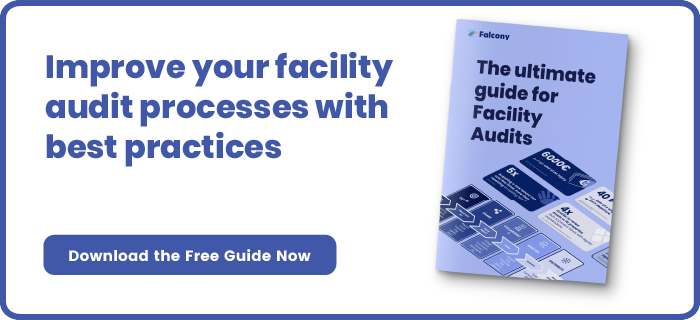How To Create A Building Inspection Checklist?
This is an updated version of a blog post originally published in October 2016.
Although smaller companies can operate from single rooms or start-up cafés, the bigger counterparts usually occupy whole buildings or several, for that matter. And even the smaller businesses work from areas that somebody else has to supervise.
For these businesses, it is important that the building they are in operates as it should. Therefore knowing how to create a building inspection checklist is a crucial part of the know-how of any facility or property manager. We've already provided general guidelines for creating great checklists, but this blog post introduces more specific ideas for buildings.
Here’s a list of the 11 most common building inspection violations and recommendations on how to improve the situation.
1. Aisles, Hallways, Corridors, Stairwells
In the realm of building inspections, a critical aspect often overlooked is the condition of aisles, hallways, corridors, and stairwells. It's imperative that these pathways remain unobstructed, allowing smooth egress in the event of an emergency. Furniture or objects impeding these escape routes can pose serious safety hazards.
Generally, all kinds of corridors should be free of furniture that can possibly obstruct people from exiting a space. However, if such a violation takes place, the next step is to promptly move the furniture away to more suitable locations. This simple action can make a significant difference in ensuring the safety of occupants within the building.
In cases where the furniture is too heavy or cumbersome to move alone, do not hesitate to ask for assistance. Safety should always take precedence, and seeking help when needed is a responsible and prudent course of action. By diligently maintaining clear and accessible pathways in aisles, hallways, corridors, and stairwells, you contribute to a safer and more secure environment for everyone in the building.
2. Exits
This is an unequivocal imperative: the exit areas must always remain free from obstructions to ensure that, in the event of an incident or accident, individuals can swiftly evacuate the premises. Therefore, it is paramount to regularly inspect and guarantee that nothing obstructs the designated exit routes.
3. Housekeeping
Housekeeping takes center stage as a cornerstone of safety and efficiency in building inspections. It's imperative that all building areas and office spaces are diligently maintained, ensuring they remain not just orderly, but also in a spotless and hygienic condition. Beyond aesthetics, cleanliness plays a pivotal role in minimizing hazards and fostering a productive environment.
To maintain an optimal level of cleanliness and safety, it's advisable to schedule regular inspections. Consistent evaluations enable you to stay proactive in identifying and rectifying potential concerns before they escalate into major problems. By adhering to a routine inspection schedule, you not only uphold the well-being and functionality of your building but also showcase your commitment to providing a safe and pleasant environment for all occupants.
4. Exit Lights
When conducting a thorough building inspection, paying attention to exit lights is of paramount importance. Begin by ensuring that these lights are not only clearly visible but also fully operational, backed by a functioning battery backup system. Take a meticulous look at the lenses and bulbs, confirming that they remain undamaged and are appropriately labeled. Additionally, check for evidence that routine maintenance has been carried out as scheduled, safeguarding the reliability of these critical safety features.
5. Fire Doors
Pay keen attention to the status of fire doors. These crucial doors typically lead to staircases and are designed to remain closed at all times. It is imperative not to prop them open under any circumstances, as doing so can have dire consequences in the event of a fire within the building. Ensuring that these fire doors are functioning correctly and remain closed is paramount to maintaining the safety and integrity of the structure.
6. Office rooms
Safety should always be a top priority when inspecting office spaces. Ensuring the well-being of occupants is essential, and that starts with considering the number of chairs and people in each room. Overcrowding can pose a serious risk in emergency situations, so it's vital to adhere to occupancy limits. The maximum number of individuals permitted in an office is directly linked to the number of exit doors available. Excessive chairs not only impede movement but also hinder swift evacuation.
Therefore, it's not only advisable but imperative to conduct a thorough evaluation of the capacity of every building and individual office space. This proactive approach will help safeguard occupants and ensure compliance with safety regulations.
7. Open Flames
In your building inspection checklist, clarity is key when it comes to open flames. Define whether candles and similar items are allowed and outline specific usage requirements.
Specify conditions for open flame use, including safety measures like using candle holders, flame-resistant materials, and designated areas, all in compliance with local fire safety rules.
Ensure that everyone understands the importance of extinguishing open flames when unattended or after events to prevent accidents and comply with safety regulations. This comprehensive approach promotes safety and responsible open flame usage within the building.
8. Electrical / Mechanical Rooms
As the name entails, electrical and mechanical rooms are dedicated solely to their intended functions. These spaces should never be repurposed as additional storage areas, and it's imperative to avoid cluttering them with chairs, tables, or any extraneous furniture. The significance of preserving these rooms' intended purposes cannot be overstated, as their functionality underpins the safe and efficient operation of the building's electrical and mechanical systems.
9. Electrical Cords
Make absolutely certain that no potential tripping hazards exist and that the electrical cords remain free from any signs of damage. It is crucial to emphasize that bundling cords together or endorsing any form of unprofessional or makeshift electrical modifications should be strictly avoided.
10. Sockets
All sockets should be well-operating and include a secure cover plate. It is of utmost importance to meticulously inspect that they are correctly installed and securely fastened. Additionally, ensure that the wiring is properly connected and tightly secured to guarantee safety and functionality.
11. Electrical Panels
One critical area to focus on is the electrical panels. It's essential to ensure a safe environment for maintenance and emergencies. The recommended clearance around all electrical panel boxes is 36 inches (~91cm). This ample space ensures easy access for personnel and allows for safe operation.
Moreover, during your inspection of electrical panels, it's paramount to go beyond the physical space requirements. Examine the condition of the panel itself, checking for signs of wear, damage, or corrosion. Any issues here could potentially pose safety hazards or signal the need for maintenance.
Lastly, take note of the labeling on the panel cover. Proper labeling is vital for identifying circuits accurately during maintenance or emergencies. Ensure that the labels are legible, accurate, and correspond to the circuits they represent. If any labels are missing or unclear, this should be addressed promptly to maintain safety and compliance with regulations.
12. Fire Extinguishers
Fire extinguishers serve as your first line of defense, and their accessibility and clear signage are non-negotiable. Rigorous monthly and annual inspections are essential, encompassing a comprehensive check of vital components. Verify the pressure gauge's accuracy, ensure the tamper seal remains intact, scrutinize the hose and nozzle for any signs of wear or damage, and meticulously assess the expiration date.
Any issues identified should be meticulously noted, with prompt scheduling of repairs or replacement as the next step. In this manner, you not only comply with safety regulations but also fortify your building's readiness for unforeseen fire emergencies.
13. Sprinklers
Maintaining effective sprinkler systems is crucial for building safety. Remember, keep a clear space of at least 24 inches (~60cm) from the ceiling and 18 inches (~45cm) from each sprinkler head for unobstructed function during a fire.
Beyond clearance, inspect the sprinkler head locations, their condition, and piping connections for any issues. Ensure control valves are operational and alarms are functional. Don't forget to check the fire department connection's accessibility.
Make detailed notes of any problems found and schedule repairs promptly. This diligence ensures the sprinkler system remains reliable, safeguarding lives and property in fire emergencies.
14. Chemicals
When it comes to chemicals, stringent protocols are essential. Start by ensuring that all chemicals are accurately and clearly labeled. This practice is crucial to prevent any inadvertent misuse. In addition to labeling, take the extra step of removing any containers that lack proper labels, as these can pose significant risks.
Beyond labeling, it's imperative to regularly assess the condition and expiration dates of chemicals in your inventory. Keeping expired chemicals can compromise safety and effectiveness. Concurrently, don't overlook the status of Personal Protective Equipment (PPE) in the designated area.
Once you have nailed the content of your building inspection checklist, it is time to think about the optimal way to conduct, share, manage and analyse them. Modern web applications have a lot of benefits when compared to traditional pen-and-paper checklists, Word documents or Excel spreadsheets. Test our Falcony | Platform FREE for 30 days and experience the difference yourself:
We are building the world's first operational involvement platform. Our mission is to make the process of finding, sharing, fixing and learning from issues and observations as easy as thinking about them and as rewarding as being remembered for them.
By doing this, we are making work more meaningful for all parties involved.
More information at falcony.io.

Related posts
Are You a Human Facility Manager?
Are you more like a human or a machine? Here is the ultimate test!
5 Tips For Creating Great Checklists
This is an updated version of a blog post originally published in May 2016.
In the process of...
Ten Different Checklists Used in the Chemical sector
Checklists are indispensable tools in the chemical and petrochemical industry for ensuring...





